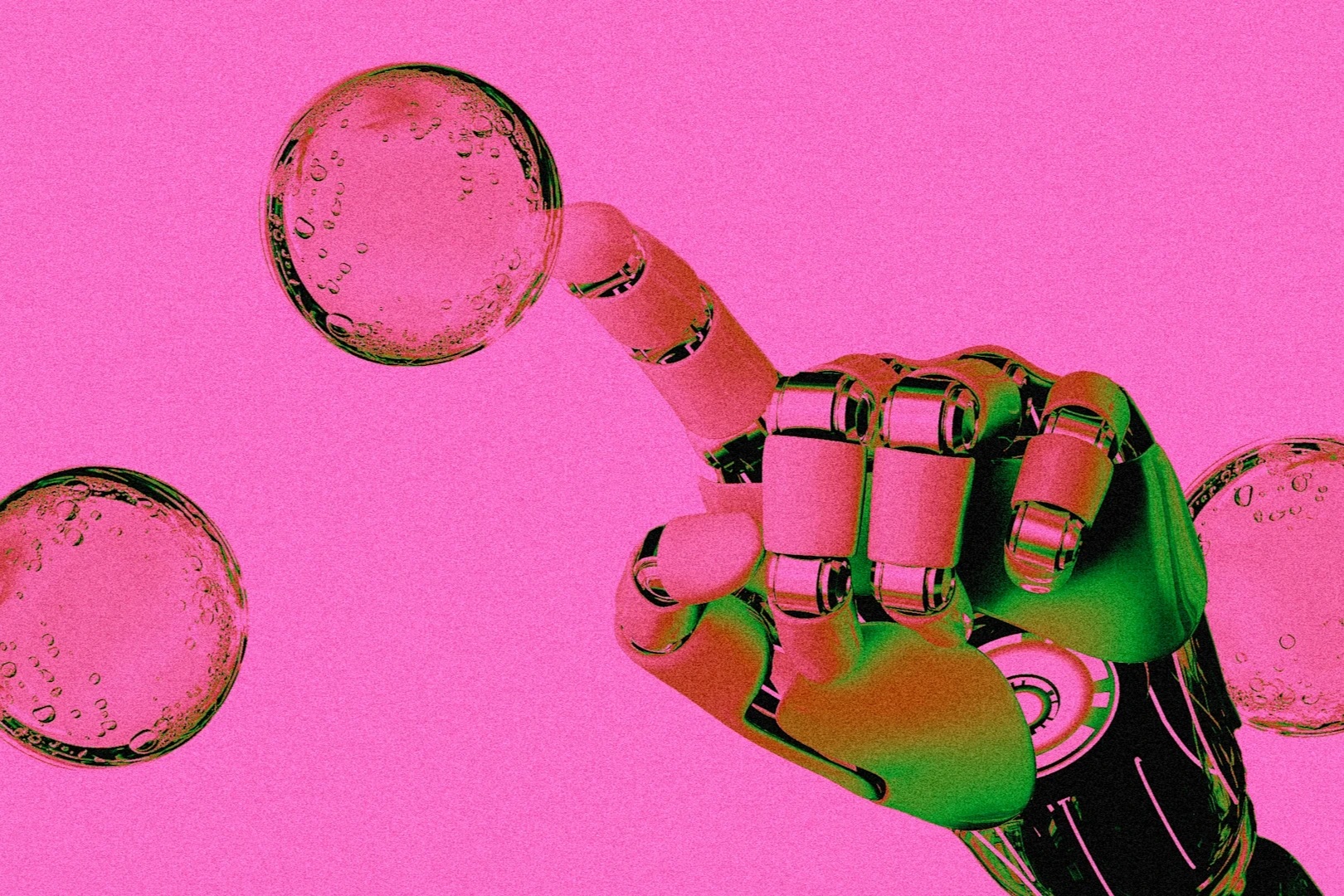“Are we at a stage where investors are getting too excited about AI? I think so,” Sam Altman, CEO of OpenAI, bluntly admitted during a press conference. He repeated the word “bubble” three times in just 15 seconds, like a chilling warning from the man at the center of the AI craze.
But while Altman is warning, Wall Street is in a frenzy. AI startups with just a few employees are raising hundreds of millions of dollars at “crazy” valuations, and optimistic analysts like Wedbush’s Dan Ives are claiming that “the AI revolution is only at the 1996 moment of the Internet,” meaning the dawn of a new era, not the peak of the 1999 bubble.
On one side are cautious tech innovators, on the other side are reckless financiers betting trillions of dollars. Between the two opposing views, the picture is actually more complicated. According to expert Faisal Hoque, there are not just one, but three AI bubbles coexisting in parallel, and understanding them is the key to businesses finding a way out when the day of “bursting” comes.
Anatomy of the AI Bubble Triad
Analyst Faisal Hoque offers a unique perspective, which is that the current AI craze is actually an overlap of three different bubbles, each with its own impacts and risks.
Asset (speculative) bubble: Modern-day "tulip mania"
This is the most visible bubble. Nvidia trades at 50 times earnings, Tesla at a staggering 200 times. The “Big Seven” tech companies are being priced on almost limitless expectations of an AI-driven future.
It’s a modern-day version of the 17th-century Dutch “tulip mania,” where speculators pushed asset prices far above their intrinsic value, driven by a simple belief that someone else would always pay more. Apollo Global Management chief economist Torsten Sløk has gone so far as to say that the 10 largest companies in the S&P 500 are now more overvalued than they were at the peak of the dot-com bubble.
For most businesses not directly involved in this financial game, speculative bubbles may seem far-fetched. However, a stock market crash would certainly cause widespread damage throughout the economy.
Infrastructure bubble: The $7 trillion race and the ghost of "railway fever"
Sam Altman may warn of a bubble, but he also said OpenAI is ready to spend “trillions of dollars” on building data centers. Giants like Microsoft, Google, Amazon, and Meta are also pouring billions into GPUs, power systems, and cooling infrastructure. McKinsey estimates the world is in a “data center race” worth as much as $7 trillion.
This recalls the late 19th century, when railroad investors built thousands of miles of excess track to meet demand that never came. Or more recently, in the late 1990s, when telecoms corporations laid down fiber optic cables across the ocean, creating a glut of capacity that would take decades to fully exploit.
Praetorian Capital analyst Harrison Kupperman did an alarming back-of-the-envelope calculation: this year’s data center investment alone will require tech companies to generate an additional $40 billion in revenue each year over the next decade just to cover depreciation. That’s double the current total AI revenue (estimated at $15-20 billion). That huge gap is the very definition of an infrastructure bubble.
Bubble Inflated Expectations: When Promises Outstrip Reality
This is perhaps the most dangerous bubble for businesses. Social media, newspapers, and boardrooms are filled with hype about the transformative power of AI. But the reality is much harsher.
A recent MIT study shocked the industry when it found that 95% of AI pilots in businesses fail to generate any profits. This number shows a huge gap between hype and actual value.

According to experts, we are facing not just one, but three bubbles inflating at the same time (Photo: Freepik).
Lessons from history: Dotcom and the "AI winter"
If a bubble exists, what are the signs that it may be about to deflate, or even burst? The latest data paints a worrying picture.
According to a regular survey by the US Census Bureau, for the first time since data collection began in November 2023, the proportion of large businesses (over 250 employees) using AI has dropped significantly in the past two months, from a peak of 13.5% to about 12%. Although the intention to use it in the next six months has not decreased, the growth rate has slowed significantly.
This is a major warning sign. It shows that after the initial experimentation phase, many companies are starting to realize the complexity and cost of integrating AI into their business processes. They are backing away.
This struggle has many similarities to the “AI winter” of the 1980s, which revolved around “expert systems” technology. Back then, leading companies also poured money into the application, some of which had initial success, but then became discouraged by the high maintenance costs and the rigidity of the systems, which easily failed in complex real-world situations.
Today, generative AI (GenAI) faces the opposite problem: it is not too rigid, but too flexible, often “hallucinating” (making up information) or taking unpredictable shortcuts. Integrating large language models (LLM) does not come with a “user manual”, requiring a huge amount of work to customize and control, leaving many businesses struggling.
Both the optimists and pessimists cite the dot-com bubble to support their views. That shows that the lessons of history are not simple.
In the late 1990s, companies like Pets.com burned through $300 million and went bankrupt, and the NASDAQ lost 78% of its value. Experts declared the Internet a fad. But from the ashes, future giants quietly emerged. Amazon built its logistics network, Google perfected its search algorithm, and PayPal solved the payment problem.
The message is clear: a technology may be overhyped, but that doesn't negate its core importance. The bursting of the bubble doesn't mean the technology is worthless. It just means that too many people got too excited and paid too much for unproven ideas.
A similar scenario is likely to play out with AI. When the market corrects, as it almost certainly will, companies that are just chasing the “trend” will fall. But those that focus on using AI to solve real business problems will be the ultimate winners.
The Pragmatist's Strategy: Profiting From the Bubble
So what should a wise business leader do in the midst of the storm? Running away from AI is not an option. Instead, approach it pragmatically and even take advantage of the bubble’s chaos.
To avoid falling into the "95% failure" trap, successful businesses often follow 3 golden rules:
"Problem-first" architecture
Don't ask "What can we do with AI?" but ask "What are the biggest bottlenecks in our operations?" Where are humans wasting time on repetitive tasks? What processes are frequently causing errors? Where are data bottlenecks delaying decisions? Only after clearly identifying the problem should you look to AI as a potential solution.
Balancing the AI Portfolio
Don't put all your eggs in one basket. Instead, mix short-term and long-term, low- and high-risk projects.
Quick Win (1-3 Months): Use existing AI tools to automate document processing, meeting summaries.
Strategic Bet (3-12 months): Build a custom AI solution to optimize a core process, such as demand forecasting or inventory management.
Breakthrough (12+ months): Test completely new business models based on AI, such as a fully automated purchasing system.
Comprehensive integration
AI projects should not exist in isolation. An AI system that controls quality in a factory can provide input to a predictive maintenance AI system. The data from that can then help another AI system optimize the supply chain. When systems “talk” to each other, they create synergy that is much greater than the sum of the individual projects.

Sam Altman, CEO of ChatGPT, worries that the AI bubble is about to burst, while Wall Street is still busy betting (Photo: DIA TV).
There is an interesting paradox: instead of being a threat, the AI bubble may be the biggest opportunity for companies that take a pragmatic approach. Venture capital is funding massive R&D that no board of directors would dare approve.
The brightest minds are leaving stable jobs to build AI tools that you can buy cheaply later. Infrastructure is being built at a massive scale, promising a future with cheaper access.
Perhaps the biggest gift of the bubble debate is that it is a distraction. While commentators and investors are busy arguing about Nvidia’s stock price or startup valuations, serious companies have an ideal space to work quietly. They face less competition for talent, less scrutiny, and less pressure to meet deadlines.
The dotcom boom left behind broadband infrastructure and a generation of web developers. The AI bubble, when it corrects or eventually bursts, will leave behind powerful GPU clusters and a generation of talented machine learning engineers.
The smartest choice is not to avoid the bubble, but to let others take the capital risk while you focus on reaping the operational benefits. The more people talk about bubbles, the more opportunities will open up for those who are steadfast and methodical.
Source: https://dantri.com.vn/kinh-doanh/khi-bong-bong-ai-no-ai-se-tru-vung-20250917084848979.htm


![[Photo] Opening of the 14th Conference of the 13th Party Central Committee](https://vphoto.vietnam.vn/thumb/1200x675/vietnam/resource/IMAGE/2025/11/05/1762310995216_a5-bnd-5742-5255-jpg.webp)

































![[Photo] Panorama of the Patriotic Emulation Congress of Nhan Dan Newspaper for the period 2025-2030](https://vphoto.vietnam.vn/thumb/1200x675/vietnam/resource/IMAGE/2025/11/04/1762252775462_ndo_br_dhthiduayeuncbaond-6125-jpg.webp)








































































Comment (0)